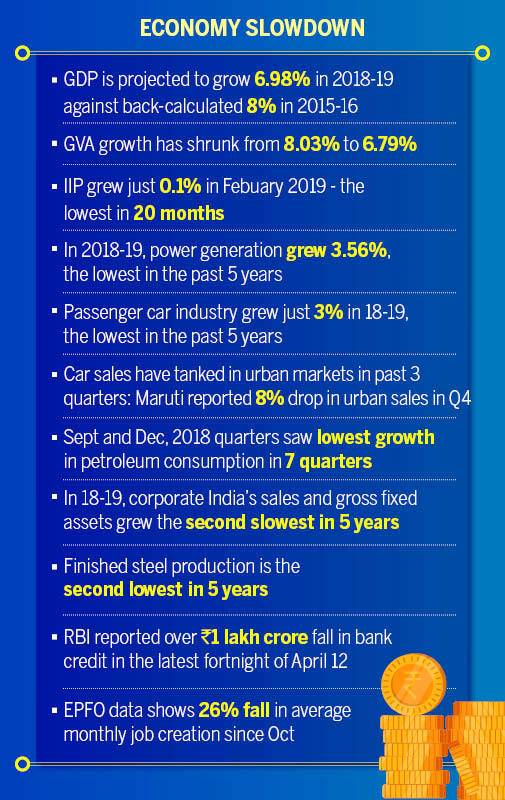
By K R Sudhaman
Prime Minister Narendra Modi might be happy to announce that the Indian economy would become the third largest in the World in the next 4 or 5 years. These numbers do not mean anything as long as millions of people are still living below the poverty line in India. Statistics can be juggled upon to paint a rosy picture but the reality is far from it. The feel good factor generated by these selective number crunching does not amuse the vast majority in Bharat like the India Shining campaign of BJP leaders of Vajpayee era in 2003-04 Modi govt needs to take a lesson from it and project a realistic picture of the economy so that correctives are taken to reverse the derailed economy.
There are external factors which could pull down the economy further. All the hype about economic recovery after Covid is certainly a bit inflated. Analysis of latest India’s exports figures says it all and the spurt is temporary.
With a fall in International crude prices, the decline in overall merchandise exports continued to be led by oil exports, which fell a massive 43.7 percent on year-on-year to $4.6 billion. Interestingly oil exports fell sequentially as well despite an on-month rise in oil prices. This implies, according to Crisil, that the decline in the dollar value of oil exports was purely on account of a decline in volumes and fortifies the slowing demand for the commodity amid slower global demand.
July this year also saw some softening in electronic goods exports, which have hitherto grown at a stellar pace and reflect the government’s early success in pushing these exports. At $2 billion, electronics goods exports were up 13.1 per cent on-year, compared with a much stronger 48.6 per cent growth achieved in the previous three months. Likewise, Pharmaceutical exports lost some steam, registering a sequential decline and paltry annual growth of 0.1 per cent, down from 5.5 per cent in the previous three months. The readymade garments, which form the bulk of India’s textile exports, continued to be in the red. Gold exports too fell.
In August 2023, food inflation scorched and the Index of Industrial Production slackened. These do not augur well for the economy. Consumer Price Index surged to 7.4 per cent in July from 4.9 per cent in June. This was driven mainly by food inflation, which accelerated sharply to 11.5 percent from 4.5 per cent, led by vegetables inflation, which jumped to 37.3 per cent from negative 0.7 per cent. Crisil is right in saying that with the sharp surge in the July CPI print, and early signs that August would see minimum relief on food prices. Consequently Crisil has revised upwards its inflation forecasts for this fiscal to 5.5 per cent on average, from its earlier estimate of 5 per cent.
Though overall manufacturing activity remains healthy, Crisil expects GDP to grow 6 per cent this fiscal compared to 7.2 per cent in the previous fiscal. This meant that the economy is slowing down and certainly not on the uptick.
Clearly the economy is not moving towards a high growth trajectory. In fact it is slowing down compared to the previous year implying all is not too well. India may be the fastest growing economy in an overall gloomy world economy but that does not mean anything as long as economic revival after Covid becomes steady and growth recovery not bumpy.
The recent spike in food inflation has created an upside to the RBI’s July-September CPI forecast at 5.2 percent , a number it now sees rising to 6.2 per cent. For the current fiscal, it expects CPI inflation print to be 5.4 per cent, 30 basis points higher than the June forecast. The spike in vegetable inflation is a recurrent, and often transient, phenomenon and the central bank can afford to look through it at the moment by not hiking short-term rates. But Crisil is of the view that high food grain inflation amid threat from weather and global development, is difficult to ignore, given its higher weight in the CPI basket.
FIEO too has raised a red flag regarding slowing exports, which does not augur well for India’s economic revival. FIEO President A Sakthivel is of the view that sluggish global demand, especially in economies like China and EU coupled with contraction in growth has led to the continuous decline in India’s exports during the recent months. Manufacturing across the Euro Zone and US has contracted due to persistent policy tightening measures by both the US Fed and the European Central Bank squeezing finances. With Britain’s pace of decline steepening, the optimism faded further. The Asian economies too are showing mixed economic recovery. Many Asian economies are struggling to maintain the momentum. The softening of the commodity prices has also pulled down value-wise exports. Monetary tightening and recessionary fears have accentuated the problem particularly with consumer spending falling across the globe.
Though Modi government may be optimistic about the possibility of a booming Indian economy and do pep talks about revival of the economy from the ramparts of the Red Fort, going forward, the economic scenario does not look all that rosy given the slowing world economy and difficult geo-political situation. India’s economy still needs a lot of fixing and demand revival is not going to be all that easy. Slowing demand world over is a matter of concern and it is going to take some time for economic recovery not only in India but world over. The government should learn to grapple with this reality and prepare the economy accordingly instead of being in election mode all the time spreading falsehood about the economy to hoodwink the people. (IPA Service)
The post Indian Economy Has Some Positive Signs But There Are Slowdown Signals Also first appeared on Latest India news, analysis and reports on IPA Newspack.


